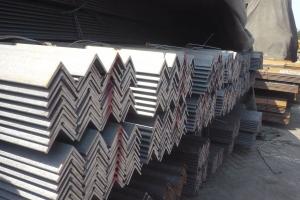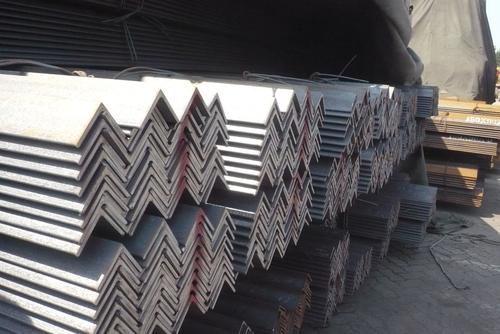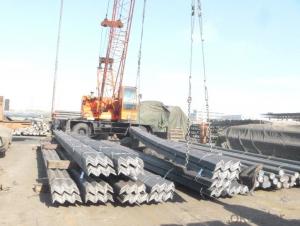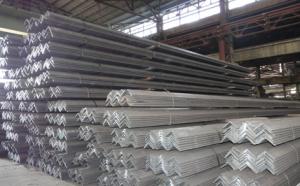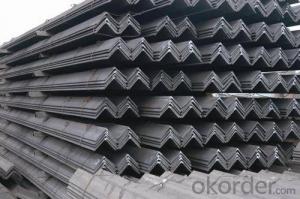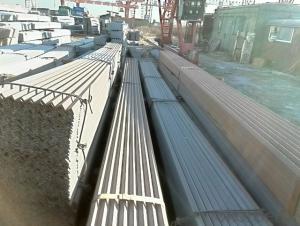Hot Rolled Angle steel;steel angle
- Loading Port:
- Tianjin
- Payment Terms:
- TT OR LC
- Min Order Qty:
- 2000 m.t.
- Supply Capability:
- 10000 m.t./month
OKorder Service Pledge
OKorder Financial Service
You Might Also Like
Product Description:
Specifications of Hot Rolled Angle Steel
1.Standards:GB,ASTM,BS,AISI,DIN,JIS
2. Invoicing on theoretical weight or actual weight as customer request3.Material:GBQ235B,Q345BorEquivalent;ASTMA36;EN10025,S235JR,S355JR;JISG3192,SS400;SS540.
4. Payment terms:
1).100% irrevocable L/C at sight.
2).30% T/T prepaid and the balance against the copy of B/L.
3).30% T/T prepaid and the balance against L/C
5.Sizes:
EQUAL ANGLES SIZES | |||
a(mm) | a1(mm) | thickness(mm) | length |
25 | 25 | 2.5---3.0 | 6M/12M |
30 | 30 | 2.5---4.0 | 6M/12M |
38 | 38 | 2.5 | 6M/12M |
38 | 38 | 3.0---5.0 | 6M/12M |
40 | 40 | 3.0---6.0 | 6M/12M |
50 | 50 | 3 | 6M/12M |
50 | 50 | 3.7---6.0 | 6M/9M/12M |
60 | 60 | 5.0---6.0 | 6M/9M/12M |
63 | 63 | 6.0---8.0 | 6M/9M/12M |
65 | 65 | 5.0---8.0 | 6M/9M/12M |
70 | 70 | 6.0---7.0 | 6M/9M/12M |
75 | 75 | 5.0---10.0 | 6M/9M/12M |
80 | 80 | 6.0---10.0 | 6M/9M/12M |
90 | 90 | 6.0---10.0 | 6M/9M/12M |
100 | 100 | 6.0---12.0 | 6M/9M/12M |
120 | 120 | 8.0-12.0 | 6M/9M/12M |
125 | 125 | 8.0---12.0 | 6M/9M/12M |
130 | 130 | 9.0-12.0 | 6M/9M/12M |
140 | 140 | 10.0-16.0 | 6M/9M/12M |
150 | 150 | 10---15 | 6M/9M/12M |
160 | 160 | 10---16 | 6M/9M/12M |
180 | 180 | 12---18 | 6M/9M/12M |
200 | 200 | 14---20 | 6M/9M/12M |
Usage & Applications Hot Rolled Angle Steel
According to the needs of different structures, Angle can compose to different force support component, and also can be the connections between components. It is widely used in various building structures and engineering structures such as roof beams, bridges, transmission towers, hoisting machinery and transport machinery, ships, industrial furnaces, reaction tower, container frame and warehouse etc.
- Q: How are steel angles used in structural framing?
- Steel angles are commonly used in structural framing to provide support and stability to various building components. These angles, which are L-shaped, are used to connect and reinforce different elements of a structure, such as beams, columns, and trusses. One of the main uses of steel angles in structural framing is to provide additional strength and rigidity to beams and columns. By attaching steel angles to the sides of these components, the angles act as braces, preventing the beams or columns from buckling or bending under heavy loads. This is particularly important in large-scale construction projects, where the structural integrity of the building is crucial. Steel angles are also used to create connections between different structural members. For example, they can be used to connect beams to columns, providing a secure and stable joint. The angles are typically bolted or welded to both members, creating a strong and durable connection. Additionally, steel angles can be used to create framing for walls, roofs, and floors. By attaching angles to the top and bottom of these components, a rigid framework is formed, which can support the weight of the structure above and provide stability during construction. In summary, steel angles play a vital role in structural framing by providing support, reinforcing connections, and creating stable frameworks. Their versatility and strength make them an essential component in the construction industry.
- Q: Are steel angles load-rated?
- Indeed, load-rating is applicable to steel angles. Steel angles serve as structural components widely employed in construction and engineering endeavors. They possess the ability to endure diverse forms of loads, encompassing axial, bending, and shear loads. The load rating of a steel angle pertains to its utmost capacity to sustain a designated load quantity without experiencing any form of failure. Thorough testing and analysis are conducted to ascertain the load ratings for steel angles, taking into account variables such as material properties, geometry, and design criteria. Typically, manufacturers furnish load ratings, which engineers utilize to guarantee the structural soundness and security of a project.
- Q: What are the different types of steel angles used in engineering?
- There are several types of steel angles commonly used in engineering applications, including equal angles, unequal angles, L-shaped angles, and T-shaped angles. Each type has its own unique properties and uses, with equal angles being suitable for general structural purposes, unequal angles used for supporting various loads, L-shaped angles for framing and bracing, and T-shaped angles for connecting and supporting components.
- Q: Can steel angles be used for framing or supporting mezzanines or elevated platforms?
- Yes, steel angles can be used for framing or supporting mezzanines or elevated platforms. Steel angles are commonly used in construction projects for their structural strength and versatility. They are often used as supports or braces in various applications, including framing mezzanines or elevated platforms. Steel angles provide stability and structural integrity, making them an ideal choice for supporting heavy loads and creating a robust framework. Their L-shaped design allows for easy installation and provides excellent resistance against bending and shearing forces. Additionally, steel angles can be easily welded or bolted together, offering flexibility in design and construction. Overall, steel angles are a reliable and effective choice for framing or supporting mezzanines or elevated platforms.
- Q: Are steel angles resistant to corrosion?
- Generally, steel angles exhibit resistance to corrosion. Typically, steel angles are manufactured from carbon steel or stainless steel, both of which possess inherent properties that resist corrosion. Carbon steel angles develop a protective layer of iron oxide, commonly known as rust, when exposed to oxygen and moisture. This rust layer acts as a barrier, preventing further corrosion of the underlying metal. Conversely, stainless steel angles contain at least 10.5% chromium, which results in the formation of a thin, transparent oxide layer on the surface. This oxide layer, referred to as a passive film, offers exceptional corrosion resistance, making stainless steel angles highly resistant to rust and other forms of corrosion. Nevertheless, it is essential to acknowledge that steel angles can still corrode under specific conditions, such as prolonged exposure to high levels of moisture or corrosive chemicals. To enhance the corrosion resistance and prolong the lifespan of steel angles, regular maintenance and proper cleaning are imperative.
- Q: Are steel angles suitable for manufacturing structural beams?
- Yes, steel angles are suitable for manufacturing structural beams. Steel angles are versatile and commonly used in construction for their strength, durability, and ability to support heavy loads. They can be easily welded or bolted together to form beams of various lengths and sizes, making them a popular choice in structural engineering.
- Q: How do steel angles contribute to the overall stability of a building frame?
- Steel angles contribute to the overall stability of a building frame by providing structural support and reinforcement. They are commonly used as braces and connections in building frames to increase their load-bearing capacity and resist forces such as wind, earthquakes, and heavy loads. The angles help distribute and transfer the loads throughout the structure, enhancing its stability and preventing deformation or collapse.
- Q: What is the typical thickness of the legs of a steel angle?
- The typical thickness of the legs of a steel angle can vary depending on the specific application and structural requirements. However, in general, the thickness of steel angle legs can range from 1/8 inch to 3/4 inch.
- Q: Can steel angles be used in machine frames?
- Yes, steel angles can be used in machine frames. Steel angles provide structural support and stability, making them suitable for constructing machine frames. They can withstand heavy loads and offer excellent resistance to bending and twisting forces, making them a popular choice in various industrial applications.
- Q: Can steel angles be used for scaffolding?
- Yes, steel angles can be used for scaffolding. Steel angles are commonly used in construction and are often selected for their strength and durability. They can provide stability and support when used as part of a scaffolding system. Steel angles can be easily connected and secured to create a sturdy structure for workers to safely access elevated areas during construction or maintenance projects. However, it is important to ensure that the steel angles used for scaffolding meet the necessary safety standards and regulations to guarantee the stability and integrity of the scaffolding structure.
Send your message to us
Hot Rolled Angle steel;steel angle
- Loading Port:
- Tianjin
- Payment Terms:
- TT OR LC
- Min Order Qty:
- 2000 m.t.
- Supply Capability:
- 10000 m.t./month
OKorder Service Pledge
OKorder Financial Service
Similar products
Hot products
Hot Searches
Related keywords
